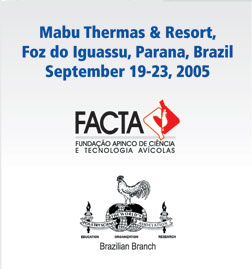Contributed Papers: Oral Presentations
Pathology |
Comparison of
E. acervulina oocyst counts in single droppings of
broilers and in droppings collected during 24 hours
F.C. Velkers1,2*, E.A.M. Graat1, J.A.Stegeman2
and M.C.M. de Jong1
1 Wageningen University, Quantitative Veterinary Epidemiology
Group, Wageningen Institute of Animal Sciences, Wageningen,
The Netherlands
2 Utrecht University, Faculty of Veterinary Medicine,
Department of Farm Animal Health, Epidemiology of
Infectious Diseases,
Utrecht, The Netherlands.
* E-mail: f.c.velkers@vet.uu.nl
At present, coccidiosis
in broilers is mainly controlled by anticoccidial
drugs in the feed. Development and evaluation of new
intervention strategies, e.g. vaccination, are necessary,
due to the increasing resistance of Eimeria spp against
anticoccidials, legislative restrictions, and consumer’s
objections against medicated feed.
Transmission experiments can play an important role
in development and evaluation of these strategies.
In future transmission experiments, both infected
and susceptible birds will be housed together on litter
to quantify the rate of transmission. Therefore determination
of OPG in individual chicks is needed. This study
was carried out to compare the OPG in droppings collected
during 24 hours with the OPG of a single dropping,
produced during one hour of individual housing in
a cardboard box.
Thirty SPF broiler chicks, individually housed in
wired floor cages, were orally inoculated at 6 days
of age (D6) with 50, 500 or 50,000 sporulated E. acervulina
oocysts or received trickle infection during 10 days
with 50 oocysts. Droppings produced during 24 hours
were collected from underneath the wired floor and
were mixed thoroughly. Furthermore, each chick was
individually housed in a cardboard box during one
hour to produce a single dropping.
The OPG of 4 g of the 24h sample and of the single
dropping was determined daily from D11-D27 using the
McMaster counting technique.
The 10Log(OPG+1) of the single dropping was significantly
associated (P<0.001) with 10Log(OPG+1) of 24-hour
faeces for all inoculation doses during the entire
course of the infection. This association is described
by a linear regression line: 10log(OPG+1)24h=0.1938
+ 0.8779 x 10log(OPG+1)single dropping.
Therefore we conclude that the OPG of a single dropping
can be used to determine oocyst production in individual
chicks, housed in the same litter pen, e.g. in transmission
experiments.
